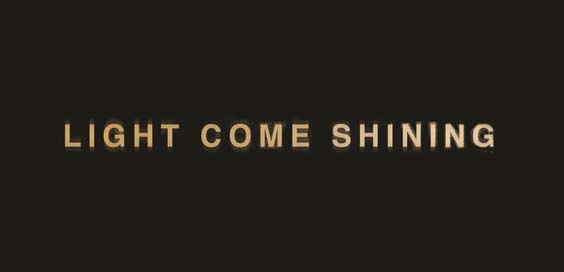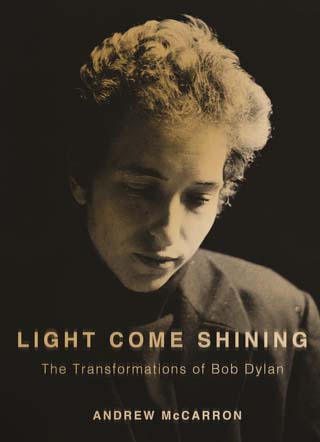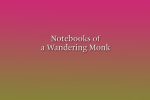Light Come Shining: The Transformations of Bob Dylan by Andrew McCarron – Review

By Barney Bardsley
Many have tried to enter, and understand, the complex psyche of Nobel Laureate and iconic rock prophet Bob Dylan. Many have tried – and failed. Like that other shape-shifting genius David Bowie, Dylan refuses steadfastly to co-operate in the game of Who Am I and Why Am I Here? His USP is his mystery: that is why he remains so exasperating, so alluring, so ultimately untouchable. Unique.
Still, that doesn’t stop us trying… And the latest to attempt to unravel the many onion layers of Bob Dylan, both the artist and the man, is Andrew McCarron. Despite publishing under an academic label, McCarron’s book is surprisingly accessible. He doesn’t succeed, any more than anyone else, in nailing Dylan to a particular cross. Indeed, Dylan himself, in his autobiographical Chronicles, seems more bewildered than anyone, by his own life. But McCarron offers many plausible and fascinating insights into Dylan’s life story: enough to make this a satisfying and intriguing read.
“Fertile ground for paranoid insecurity”
 The music of Bob Dylan is dark, haunting, full of existential loneliness. When you consider that he grew up during the Cold War, when the threat of nuclear annihilation was constant and real enough for him and his schoolmates to be drilled regularly in what-to-do-if-the-bomb-drops (i.e. climb under your desk and hope for the best), it is no wonder that a sensitive boy would internalise that terror and use it as raw material for his art. Add to that, the fact that he was born to Jewish immigrants, both of whose families escaped the pogroms of Russia and Eastern Europe – and who schooled him relentlessly in the horrors of the holocaust – and you have fertile ground for paranoid insecurity, not just regarding his personal safety, but also the stability of the whole world. Bob Dylan was never going to go into real estate.
The music of Bob Dylan is dark, haunting, full of existential loneliness. When you consider that he grew up during the Cold War, when the threat of nuclear annihilation was constant and real enough for him and his schoolmates to be drilled regularly in what-to-do-if-the-bomb-drops (i.e. climb under your desk and hope for the best), it is no wonder that a sensitive boy would internalise that terror and use it as raw material for his art. Add to that, the fact that he was born to Jewish immigrants, both of whose families escaped the pogroms of Russia and Eastern Europe – and who schooled him relentlessly in the horrors of the holocaust – and you have fertile ground for paranoid insecurity, not just regarding his personal safety, but also the stability of the whole world. Bob Dylan was never going to go into real estate.
McCarron cleverly focuses on three turning points in Dylan’s life: his motorbike accident in 1966; his conversion to Christianity in 1978; and his return to touring and performing after a fallow patch, in 1987. The accident that occurred in Dylan’s twenties, when he was at the peak of his ascent to super-stardom, shook the young man to his foundations. He had always been pursued by images of death and catastrophe: but now the reality had struck his own body. It precipitated a lengthy crisis, both artistic and personal, and prompted a complete withdrawal into the world of hearth and home. Marriage and fatherhood took over – and probably saved his sanity.
“Bored and confounded his fans”
One song shines like a beacon from this era. Recorded in the summer of 1967, and ostensibly a prison ballad – in the tradition of blues and folk songs from time immemorial – ‘I Shall Be Released’ contains lyrics of such sadness and yearning, that one cannot help but imagine, as does McCarron, that this is not just a ballad, but a plea from Dylan for salvation:
I see my light come shining
From the west unto the east
Any day now, any day now
I shall be released.
Salvation did indeed soon come, in the form of a cataclysmic conversion to Christianity, something which bored and confounded his fans, quite as much as his – “Judas!” – conversion from acoustic to electric in 1965. But Dylan stood firm in his new convictions, and does so, to this day. For a man so haunted by fame – which came young, and sat uneasily on his diffident shoulders – and for someone so possessed by visions of the apocalypse, faith in an all-caring and protective god must have been a huge relief to Dylan. It’s hard to begrudge him that.
“Prescient and uncanny”
Although he has always fought shy of party politics, Dylan never fails to capture the mood of the times. Over and over, he has produced rock anthems perfectly suited to the age in which we live. And none has been more acute, in this regard, than ‘A Hard Rain’s Gonna Fall’, which was written, according to McCarron, in direct response to the 1962 Cuban Missile Crisis.
At a moment when there was the very real prospect of a nuclear standoff between America and the Soviet Union, Dylan let rip with a hail of vocal bullets of his own:
Oh, what did you see, my blue-eyed son?
Oh, what did you see, my darling young one?
…
I saw 10,000 talkers whose tongues were all broken
I saw guns and sharp swords in the hands of young children
And it’s a hard, it’s a hard, it’s a hard, it’s a hard
And it’s a hard rain’s gonna fall.
In the era of ISIS, these words seem prescient and uncanny.
“Adds memorably to the Dylan kaleidoscope”
McCarron concludes his book with a look at Dylan’s ‘third age’, with his renewed enthusiasm for song writing and performing. He examines Dylan’s musical roots, his heroes – Woody Guthrie, Buddy Holly – and his enduring passion for the radio as a medium. And he includes a well-chosen comment from playwright Sam Shephard, that sums up the Bob Dylan phenomenon with pleasing clarity.
“Dylan has invented himself. He’s made himself up from scratch. That is, from the things he had around him and inside him. Dylan is an invention of his own mind. The point isn’t to figure him out but to take him in.”
Bob Dylan is an invention we have all needed, to reflect our fractured world back to us: not in the spirit of making things better, but in the groove of making things heard, felt – and, crucially, shared, with others. Andrew McCarron’s narrative adds memorably to the Dylan kaleidoscope, by describing the ever-changing colours and moods of someone who is less of a person, more a phenomenon of his – and our – time.
‘Light Come Shining: The Transformations of Bob Dylan’, Andrew McCarron, PhD, £12.49, Oxford University Press 2017









